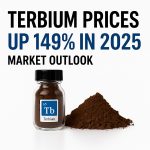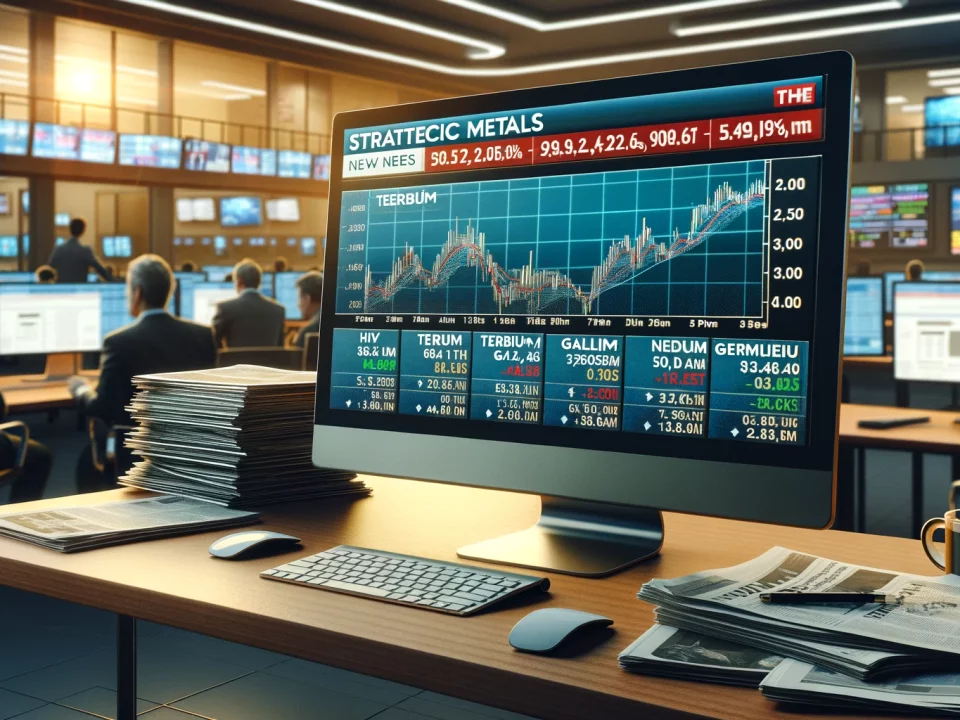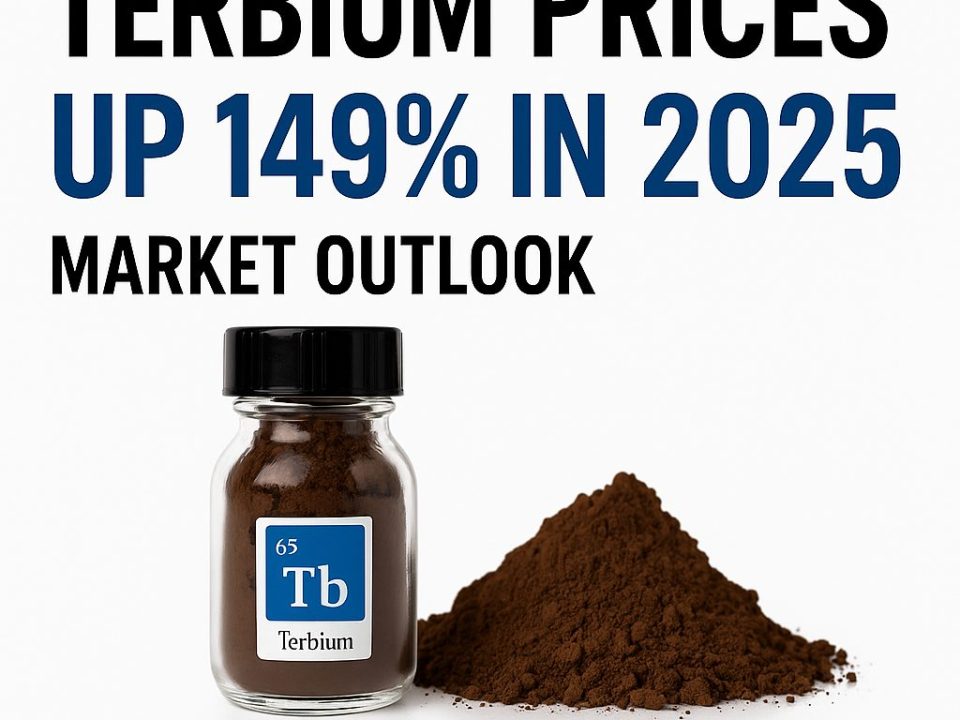
Weekly News Review November 10 – November 16 2025
November 16, 2025
Terbium’s Standout Year: Why This Heavy Rare Earth Just Climbed 149% — And What Comes Next
November 27, 2025The Chinese customs authorities released detailed October export data, revealing ongoing supply constraints and divergent trends across key materials. Meanwhile, supply-chain diversification efforts continue, with the European Investment Bank and Australia finalizing an agreement that could pave the way for European financing of resource projects Down Under.
All this and more from the editorial team @rohstoff.net
UNITED STATES DOE ANNOUNCES INVESTMENT OF $355 MILLION FOR DOMESTIC PRODUCTION OF RARE EARTH MINERALS:
The U.S. Department of Energy (DOE) has announced $355 million in grant funding across two programs to expand domestic critical mineral production and reduce reliance on foreign suppliers. Of the total, $275 million will support the development of pilot-scale facilities that extract critical minerals from coal waste and other secondary mining.
The remaining $80 million will fund the development of demonstration sites for next-generation mining technology, with a focus on automation, real-time imaging, and advanced separation systems. This initiative represents the DOE’s first significant investment in mining technology in nearly four decades, according to the department’s press statement.
The background to the two programs is the U.S.’ heavy dependency on foreign sources of critical minerals, with China holding dominant positions across multiple supply chains. The new DOE measures form part of a broader federal effort to diversify mineral sourcing and bolster U.S. supply chain resilience. In July, the Department of the Interior also launched a push to accelerate the recovery of critical minerals from abandoned mines and mine waste (we reported).
The DOE announcement also comes amid heightened geopolitical attention on rare earth cooperation. Earlier this month, a rare-earth framework agreement between Washington and Beijing made headlines; however, conflicting information persists about the deal’s overall scope. Treasury Secretary Scott Bessent said in remarks aired Sunday that a final agreement would “hopefully” be reached by Thanksgiving.
CANADA’S NEO PERFORMANCE MATERIALS ANNOUNCES STRONG PERFORMANCE IN 3Q:
Progress toward Europe-made rare earth magnets.
Neo Performance Materials reported strong third-quarter 2025 results, with revenue rising nearly 10% year over year. The Canadian company says it is firmly on course to expand its permanent-magnet business. CEO Rahim Suleman highlighted key milestones, including the opening of Europe’s largest rare earth magnet factory in Estonia.
Full-scale production is scheduled to commence in mid-2026 with an initial annual capacity of 2,000 tonnes, which could later be expanded to 5,000 tonnes.
The company is also advancing the development of a production line for heavy rare earth elements. This new line is being built within Neo’s light rare earth refinery, located about a 30-minute drive from the magnet facility it will eventually supply with dysprosium and terbium. According to Suleman, small-scale production of separated heavy rare earths is expected to start in 2026, as he explained during a conference call on the quarterly results.
AUSTRALIA: VIRIDIS SECURES BACKING FOR BRAZILIAN RARE EARTH DEVELOPMENT:
Australian rare earth developer Viridis Mining and Minerals has received a Letter of Interest (LOI) from Export Development Canada (EDC) to support its Colossus rare earth project in Brazil. The non-binding offer of up to $100 million marks the third expression of government-level financing interest in the operation, following earlier approaches from France’s export credit agency and Brazilian development institutions.
Colossus is an ionic adsorption clay (IAC) rare earth deposit, a type that can be mined without drilling or blasting. Instead, the clays are leached with chemical solutions to release the rare-earth elements, making IAC deposits easier to develop and generally less capital-intensive than conventional hard-rock projects. This type of deposit is currently only commercially mined in Southern China and neighboring Myanmar, with some analysts believing Brazil could emerge as an alternative supplier in the future.
Viridis has previously reported strong metallurgical results from the project. In April 2024, the company announced ionic recoveries of up to 63 percent, one of the highest levels recorded globally for clay-hosted rare earth deposits.
The financing interest from EDC adds to the agency’s recent push into critical minerals. In June, EDC announced up to $250 million in support for a rare earth project in British Columbia, and it was among the first government lenders to back Australian developer Arafura’s Nolans project in the Northern Territory.
EU: EUROPEAN INVESTMENT BANK TO FINANCE RAW MATERIALS PROJECTS IN AUSTRALIA:
The European Investment Bank (EIB) and the Australian government signed a memorandum of understanding on Monday to strengthen their cooperation on critical raw materials. The aim is to facilitate EIB financing for relevant projects in Australia. The partnership builds on an existing raw materials agreement between the two parties, signed in May 2024 (we reported).
Resource-rich Australia aims to position itself as an alternative to China, the dominant global supplier, and is already a major producer of lithium, nickel, and rare earth elements. The EU, for its part, is seeking to diversify its supply chains, particularly in light of the bloc’s first-ever law on securing raw materials, the Critical Raw Materials Act. The act stipulates that by 2030, no more than 65 percent of the EU’s annual consumption of any critical raw material may come from a single non-EU country.
Australia is considered a reliable supplier of critical minerals, and its partnership with the EU underscores the shared commitment to sustainable development and secure supply chains, said Angus Campbell, Australia’s Ambassador to the European Union. He signed the memorandum together with EIB Vice-President Nicola Beer.
USA ON THE HUNT FOR CRITICAL RAW MATERIALS:
The United States is ramping up pressure not only in building supply chains for critical raw materials but also in buying up overseas stockpiles. In their push to reduce dependence on China, the dominant global player in raw materials, the U.S. is increasingly beating European buyers to the punch, according to EU Commissioner Stéphane Séjourné in an interview with the Financial Times.
Séjourné, who oversees the EU’s industrial and trade policy, wants to counter this trend with a new EU body equipped with its own funding to coordinate joint purchases and build strategic reserves. The institution is also intended to encourage companies to strengthen the economic security of their supply chains. Raw-material partnerships, for example, with Brazil, are expected to complement the bloc’s efforts to gain more autonomy in securing resources.
The differing pace and approach on both sides of the Atlantic was recently noted by Erik Eschen, CEO of Vacuumschmelze, in a conversation with Bloomberg (paywall). The U.S., he said, is currently setting the tone in (re)building domestic supply chains, while European industry and policymakers wait for solutions from either the U.S. or China.
Europe does have expertise in rare earths, Eschen added, but this know-how is increasingly migrating abroad, to the U.S., Canada, and Australia. Vacuumschmelze, headquartered in Hanau, Germany, produces magnetic alloys and permanent magnets. The company recently opened a magnet plant in South Carolina, backed by roughly $200 million in government subsidies and tax credits.
Philippe Kehren, CEO of French rare-earth group Solvay, voiced similar concerns. “We still feel limited support in Europe today. That’s why we continue to work with European policymakers to determine how we can create the right framework conditions. To be very clear: we are currently seeing more support coming from North America.” Concrete examples of Europe losing expertise and capacity include the canceled construction of a rare-earth refinery in Hull, England, and the sale of British rare-earth metals and alloys producer Less Common Metals to a U.S. company.
KAZAKHSTAN SEEKS TO DEVELOP RARE EARTH DEPOSITS IN RWANDA AND AFGHANISTAN:
The resource-rich Central Asian nation aims to strengthen its role in global supply chains.
With its vast, partly unexplored mineral reserves, Kazakhstan is positioning itself as an emerging producer of critical raw materials. At the same time, the country is seeking to secure new mineral sources abroad. According to the Astana Times, the state-owned mining company Tau-Ken Samruk has begun geological exploration for rare earth deposits in Rwanda and Afghanistan. Through targeted partnerships in both countries, Kazakhstan hopes to reinforce its position within global critical-mineral supply chains, said Nurlan Zhakupov, CEO of the sovereign wealth fund Samruk Kazyna, which oversees Tau-Ken Samruk.
In Rwanda, a bilateral agreement has already been signed, and five target zones have been identified. Pending approval from Rwandan authorities, a joint venture for exploration and later mining is expected to be established before the end of the year. In Afghanistan, initial field studies have revealed promising potential; exploration work is ongoing, along with discussions with potential local partners.
According to Zhakupov, Kazakhstan aims not only to secure raw materials overseas but also to process them domestically to increase value creation within the country.
Rwanda, like many African nations, seeks to upgrade its mining sector by expanding domestic processing rather than exporting raw materials. The country is a significant producer of tantalum, tin, tungsten, and gold, and also holds potential for lithium and rare earth elements.
Afghanistan likewise has abundant mineral resources, including iron, gold, lithium, and rare earths. However, several factors hinder wider exploitation: the rugged terrain complicates mining operations, and the country lacks both infrastructure and a stable legal and political framework. Analysts also warn foreign investors of serious security risks. The Taliban government, in power since 2021, is officially recognized only by Russia; Kazakhstan and some other countries have instead adopted a pragmatic approach. Until now, China has been seen as the primary foreign actor interested in Afghan mining projects.
USA: RARE EARTH JOINT VENTURE ANNOUNCED IN SAUDI ARABIA:
U.S. Department of Defense joins refinery project.
In May, the Saudi state-owned mining company Ma’aden and the U.S.-based MP Materials signed a memorandum of understanding to develop a fully integrated rare earth supply chain. The partnership is now taking shape. With U.S. Department of Defense participation, the two sides plan to establish a joint venture to build a rare-earth refinery in Saudi Arabia. The feedstock is expected to come from deposits within the Kingdom and from other regions. The facility will produce both light and heavy rare earth elements.
According to MP Materials, the company is also in discussions about how to support local production of rare-earth magnets. Saudi Arabia has been pursuing ways to diversify its economy and reduce its dependence on oil exports. The country sees strong potential in untapped mineral resources, including lithium, gold, and rare earth elements, valued at $2.5 trillion.
The latest agreement follows a series of deals between the United States and Saudi Arabia aimed at strengthening bilateral relations.
CHINESE GALLIUM EXPORTS HIT HIGHEST LEVELS SINCE 2022, GERMANIUM LAGS:
China’s exports of the technology metals gallium and germanium rose sharply in October, according to the latest data from the country’s customs administration.
A total of 15,570 kilograms of gallium were shipped abroad, a strong rebound from September’s 5,000 kilograms and the highest monthly volume recorded since June 2022. Germany was again the leading destination with 10,000 kilograms, followed by Japan with 5,000 kilograms. Smaller quantities also went to Malaysia, South Korea, and Thailand.
Exports of germanium also increased significantly, reaching 1,258 kilograms, more than twice that of September’s 523 kilograms. The majority went to Russia with 930 kilograms, followed by Germany with 222 kilograms and Taiwan with 100 kilograms. Bulgaria and Belarus each received 3 kilograms.
Year-to-date data show that germanium exports in the first 10 months of 2025 are less than half of last year’s volume, while gallium exports are slightly above last year’s volume. This indicates that the export levels of the two metals are developing differently.
Since mid-2023, China, the world’s leading producer, has maintained strict export licensing requirements for gallium and germanium, limiting the volumes available on global markets. Additionally, China had imposed an explicit export ban on shipments to the United States in December 2024. While this measure was temporarily suspended in early November 2025 following negotiations between the two sides, earlier export controls remain in place and continue to influence international supply chains.
CHINESE DYSPROSIUM EXPORTS PLUMMET IN OCTOBER WHILE TERBIUM REBOUNDS:
China’s latest customs figures show sharply contrasting trends in October for dysprosium and terbium exports.
According to the latest customs data, Chinese dysprosium shipments fell dramatically to 3,501 kilograms in October, down from 18,043 kilograms in September. The bulk of exports went to South Korea, with 2,701 kilograms, followed by Estonia with 500 kilograms and Japan with 300 kilograms. Year-to-date, dysprosium exports are down around 27 percent compared with the same period last year, highlighting ongoing supply constraints for this critical rare earth element.
In contrast, terbium exports rebounded to 12,200 kilograms, up from 4,450 kilograms in September, marking the highest monthly volume this year. The United States received 6,000 kilograms, Japan 5,200 kilograms, and Estonia 1,000 kilograms. Year-to-date, terbium exports are down roughly 20 percent.
Both metals remain subject to China’s export licensing system introduced in April, which requires official approval for all shipments abroad. Dysprosium and terbium are key raw materials for high-performance permanent magnets, essential components in electric vehicles, wind turbines, and other advanced technologies.
CHINESE EXPORTS OF RARE EARTH MAGNETS DOWN IN OCTOBER:
Exports of rare earth magnets from China declined again in October. According to data from the Chinese Customs Authority, 5,473 tons were shipped, down from 5,774 tons in September. The bulk of the shipments went to Germany, which accounted for 20 percent of total exports, followed by the USA, South Korea, Vietnam, and India, countries with strong or emerging automotive industries.
Exports of rare-earth magnets had already fallen significantly a few months ago after Beijing introduced export controls for certain rare-earth elements and products made from them. Many types of magnets contain raw materials covered by these regulations (such as dysprosium and terbium). Because customs codes do not differentiate by composition, the approval process for all rare-earth magnets has been delayed.
SOUTH AFRICA AND THE EU TO COOPERATE FOR RARE EARTH MINERAL PROCESSING:
The EU and South Africa have agreed to strengthen their partnership in the minerals and metals sector. A corresponding memorandum of understanding was signed one day before the G20 summit in Johannesburg, South Africa. The signatories were Stéphane Séjourné, EU Commissioner for Industry and Trade Policy, and Gwede Mantashe, South Africa’s Minister of Mineral Resources and Energy. Alongside the raw materials agreement, government representatives also concluded a partnership on clean trade and investment, as well as new initiatives under Global Gateway, the EU’s geopolitical investment strategy.
The goal of the raw materials cooperation is to establish sustainable value chains in which materials are processed primarily within South Africa. This aligns with the country’s ambition to capture more value from its abundant natural resources; currently, much of the extracted raw material is shipped abroad for processing. South Africa holds the world’s largest reserves of platinum-group metals and is the leading global supplier. The country is also a major producer of chromium, manganese, gold, and vanadium.
Closer cooperation on critical minerals had already been announced in March during the EU–South Africa summit. The Zandkopsdrift rare earth and manganese deposit in the Northern Cape Province is among the projects designated as strategic under the EU’s Critical Raw Materials Act (CRMA). The deposit, being developed by Luxembourg-based Frontier Rare Earths, will therefore benefit from accelerated permitting procedures and easier access to EU financing.
US TO EXPAND SCANDIUM AND GALLIUM SUPPLY WITH NEW $30 MILLION INVESTMENT:
ElementUS secures almost $30 million from the Department of Defense.
The United States Department of Defense has awarded $29.9 million in Defense Production Act funding to ElementUS Minerals to build a facility in Gramercy, Louisiana, that will extract gallium and scandium from bauxite residue, an industrial waste stream. Additional development work will take place in Cedar Park, Texas. The effort is intended to make ElementUS one of the first U.S. producers of both minerals.
The move follows September’s announcement that the Defense Logistics Agency will add scandium, although not gallium, to the National Defense Stockpile, with the U.S. set to purchase 6.4 metric tons of scandium oxide over five years in a contract worth up to $40 million with Rio Tinto, the only current North American producer. Rio Tinto’s scandium operations are based in Canada, however.
Scandium, though limited in commercial use, is vital for aerospace alloys, lasers, and defense technologies, while gallium is essential for semiconductor manufacturing. Both markets are dominated by China, leaving the U.S. heavily reliant on imports.
FIGURE OF THE WEEK: 50% of the material value of an electric vehicle comes from copper, battery minerals and rare earth elements.






